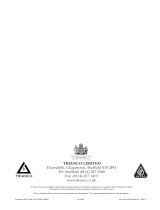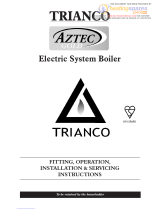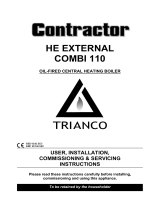
11
Grant Vortex Oil Boilers
4 - GENERAL BOILER INFORMATION
Boiler description
4.1 Green system......Standard external high level/
vertical flue starter kit (room sealed) - components
available:
External high level/vertical flue starter kit short
(room sealed)
Extensions 150 mm, 250 mm, 450 mm, 950 mm
and adjustable 195 to 270 mm
45° elbow
High level terminal
Vertical terminal
White system ......High level concentric balanced flue
kit - components available:
Extensions 225 mm, 450 mm, 950 mm and
adjustable 275 to 450 mm
45° elbow
Vertical concentric balanced flue kit
Extensions 225 mm, 450 mm, 950 mm and
adjustable 275 to 450 mm
45° elbow
All burners are pre-set for use with kerosene and are
supplied ready to connect to a single pipe fuel supply
system with a loose flexible fuel line and 3/8" to 1/4" BSP
male adaptor supplied with the boiler.
If required, an additional flexible fuel line (600 mm) and
3/8" to 1/4" BSP male adaptor are available to purchase
from Grant Engineering (UK) Limited, for two-pipe oil
supply systems, Part No. RBS104.
The temperature of the water leaving the boiler to heat
the radiators and hot water cylinder is User adjustable.
The boiler is fitted with an overheat thermostat (which
allows it to be used on a sealed central heating system) which
will automatically switch off the boiler if the heat exchanger
exceeds a pre-set temperature of 111° C ± 3° C.
The control panel is fitted with an ON/OFF switch,
boiler thermostat control knob and the manual reset
button for the overheat thermostat. An optional plug-in
programmer is available to purchase from Grant
Engineering (UK) Limited for Kitchen models which
allows the User to set the operating times for central
heating and hot water, Part No. EPKIT.
Kitchen and Kitchen System: The boiler casing door is
factory fitted with the hinges on the left hand side. If
required, the door may be hinged on the right hand
side as follows:-
Remove the hinge pin from the top of the door and the
bottom hinge bracket. Refit them to the other side of
the door and boiler casing. Adjust the bottom bracket
until the door is correctly aligned.
Boiler components
4.2
The Grant Vortex range of automatic pressure jet oil
boilers have been designed for use with a fully pumped
central heating system with indirect domestic hot water
cylinder. They are not suitable for use with either a direct
cylinder or a 'primatic' cylinder or gravity hot water..
The boilers are suitable for use on sealed central
heating systems. System models are supplied with the
necessary components factory fitted. See Section 4.13.
All models are supplied with the control panel and
burner factory fitted.
The boilers can be connected to either a conventional
flue system or a balanced flue system, as required.
For Conventional flue applications where a chimney is
to be lined - Grant recommends the use of the Grant
‘Orange’ flue system, specifically designed for the
Vortex range of condensing boilers. Refer to Section
4.7 for further details.
Where a rigid conventional flue - either internal or
external - is required, Grant recommends the use of the
Grant 'Green' and 'Orange' flue system components. As
no flue adaptor is supplied with the boiler it will be
necessary to purchase the Grant CF adaptor kit in
order to correctly connect the 'Green' and 'Orange
system flue components to the boiler.
Flue adaptor kit - Ref. CFA15/70 - is used for all Vortex
models from 15 to 70 kW as they all can use the 100 mm
'Green' and 'Orange' system components to construct a
flue of maximum vertical height 8 metres.
Important: The flue system materials and construction
MUST be suitable for use with oil-fired condensing
boilers. Failure to fit a suitable conventional flue may
invalidate the warranty on the boiler.
Fitting instructions for the Low level concentric, High level
and Vertical balanced flue kits are supplied with the kits.
Where a balanced flue system is required, the following
flue kits are available from Grant UK.
Refer to Section 4.8 for further details.
Yellow system.....Standard low level concentric
balanced flue - components available:
Low level concentric balanced flue short
Extensions 225 mm, 450 mm and 675 mm
90° extension elbow
45° extension elbow
45° elbow


























